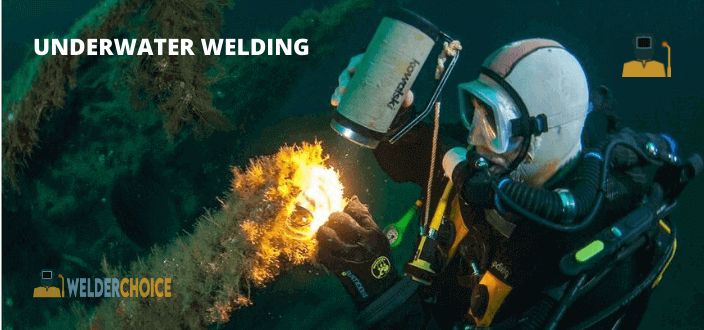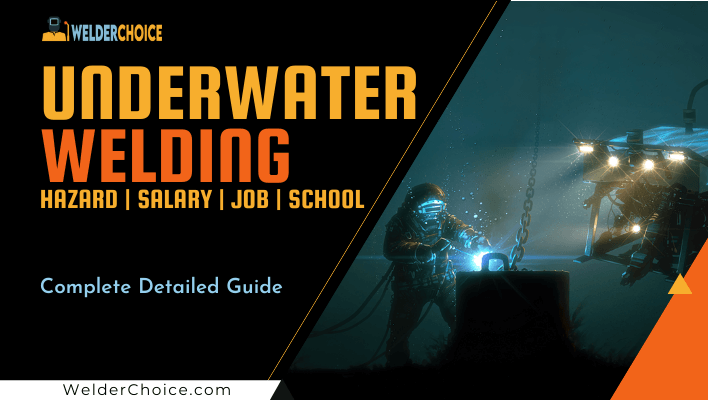Welders who perform underwater welding, are in higher demand than they have ever been.
Underwater welding is required for underwater construction and repair. A certified diver with training in underwater welding can make a solid life.
The construction of deep-sea pipelines, oil and gas exploration, and maritime infrastructure are all on the rise.
These features combine to make this a fantastic welding specialty.
What is Underwater Welding
Divers with commercial training work submerged underwater to do underwater welding.
This could happen in a different dry location or in the wet water. Underwater welders can be found working in a range of environments, including underwater construction, underwater surveying, and offshore construction.
There are openings in nuclear power, mining, pipelines, the military, and public dams/canals/locks. Underwater repair jobs can also be found in industries like oil and shipbuilding.
Underwater welding can be done wet or dry. When the diver is submerged, he or she does underwater wet welding. A shielded metal arc welding is used. Gas bubble is produced by the arc on the stick welder which protects the weld.
The welding equipment is powered by DC electricity, which is transmitted via an underwater cable.
During underwater dry welding, dry enclosures are built around the weld region. Air is forced into a chamber to form a workspace. The diver must operate in sufficiently pressurized air to make a weld.
Official training from a recognized institution or program is required for underwater welders.
Certification standards are set by AWS. The welder must also complete a commercial diver certification/licensing program. This occupation demands extensive education.
As a result, underwater welding is considered a niche industry.
Underwater Welding Hazards and Risks
Underwater welders work with a lot of heavy machinery that is designed specifically for their task. They work in an atmosphere that is unstable and often dangerous. It’s unsurprising that there’s a great deal of risk.
When diving, welders are at risk of decompression sickness (“the bends”), overheating, and drowning. Being a certified diver who performs proper diving techniques is essential.
Underwater visibility is less than on the surface. As a result, the chances of making a mistake are increased.
Welders operate with electricity and flame, both of which are dangerous by nature. When you’re underwater, these threats are compounded.
Deeper water is also riskier than shallower water.
The risk of explosion in offshore underwater welding is higher due to the amount of fuel stored on offshore oil rigs and marine vessels.

Your welding arc may also be erratic in a pressurized chamber. This raises the risk of a shock or explosion. Furthermore, if gases enter the chamber it may be dangerous.
All of these dangers are manageable. Our goal isn’t to frighten you out of your existing job. It’s important to note, though, that working in welding industry needs even more prudence.
Related Post: Underwater Welding Hazards
Underwater Welding Pay and Salary
A commercial diving company frequently employs underwater welders. Many are engaged directly by marine construction companies, shipping companies, oil and gas companies, and the military.
Due to the nature of their employment, underwater welders are usually away from home for months at a time.
This type of welding has some of the highest compensation in the industry. Given the specific training and skill sets required, this is reasonable.
The project usually compensates for underwater welders. The amount they are paid is mostly dependent on the environment in which they will be diving, the depth of the project, the diving style used, and the type of welding required.
According to AWS, underwater welders can earn $100,000 to $200,000 per year.
Underwater welders are required both offshore and inland. Underwater welders working in the inland make between $50,000 and $80,000 per year.
Because of their employment, they don’t have to travel much or spend long periods of time away from home. They can also anticipate a typical 40-hour workweek.
Welders working offshore might earn up to $100,000 per year. Their workweek is significantly longer, and they travel frequently. It necessitates a significant amount of travel and time away from home. Welders who labor offshore, on the other hand, may only be employed for around half of the year.
Related Post: Underwater Welding Salary
Underwater Welding Jobs
In practically any industry or application that involves structures, resources, or underwater operations, a welder underwater is required.
Inland welders are underwater welders who work in ponds, rivers, and lakes.
Docks, bridges, dams, and small boats are all typical construction projects.
The bulk of inland welding vocations is in freshwater welding. This can be a less stable environment because of the absence of buoyancy.
Off the coast, underwater welders work in deep-sea conditions. They may work on oil rigs and massive marine vessel hulls, as well as welding pipes, installing I-beams under platforms and servicing large underwater gear.
Offshore underwater welders might spend months at a time working on an oil rig or a ship. They work more than 60 hours a week on a regular basis. In poor weather or during the winter, offshore underwater welding is not practicable. Many offshore underwater welders are only operational for a few months out of the year.
Wet and dry welding procedures are available to underwater welders. It is determined by the project on which they are engaged.
Related Post: Best Tig Welder
Wet Underwater Welding Jobs
Wet welding takes place when the welder is submerged in water. Waterproof stick welding equipment is utilized when the metal to be fused is surrounded by water.
While wet welding is less expensive, brittleness can damage the integrity of the weld and cause it to break. This approach is used by only a few programs.
Dry Underwater Welding Jobs
Dry welding takes performed in a submerged pressurized container. The welder and the weld junction are in a water-free chamber.
Although dry welding produces excellent welds, it is an expensive technique.
Dry welding is separated into two types.
1. Cofferdam Welding
This type takes place in a pond or enclosure with water. It’s built and secured with sealed clamps to the framework that will be welded.
Welders work in a dry atmosphere thanks to the use of valves to drain the water. Cofferdams are frequently used to build or repair bridge piers, docks, locks, and dams.
2. Hyperbaric Pressure Welding
This type is performed underwater under tremendous pressure. The diver is in a devoid of water, life-sustaining hyperbaric chamber. The chamber is constructed to encapsulate the welded joint or area.
The chamber is filled with high-pressure gas to force the water out. This creates a dry atmosphere for the diver to perform any necessary repairs or construction. In addition to commercial diving certification, hyperbaric welding demands specific welding training.
Related Post: Types of Welding Jobs
Underwater Diver Schools and Training Programs
As students advance through welding education and training programs, they frequently progress from basic to more challenging welding positions and joint types. Welding lessons for beginners might last anywhere from 10 to 15 days.
However, becoming an underwater welder necessitates further training. The majority of people that are interested in this subject start by learning the basics of welding.
Following that, you should investigate commercial diving. This is a step up from the scuba instruction you might have received on your Florida Keys vacation. An underwater welder required a commercial diver certification.
Following that, you’ll learn to weld underwater for up to seven months.
The Best Underwater Welding Schools
Let’s take a look at three of the country’s greatest underwater welding schools.
Just a few of the options are available.
1. Hydroweld, United States
Hydroweld USA is headquartered in Miami, Florida. They specialize in underwater wet welding instruction for experienced welders.
They have a 45,000-gallon tank that has been filtered and treated. Three welding stations have set up in the tank. Allowing trainees to move work components in any orientation required for underwater positional welding.
Instructors have direct visual and audio communication with pupils to monitor progress and deliver real-time education. After successfully completing the course, students receive a Lloyds Register Welder Performance Qualification (WPQ). This means that they meet the class “B” weld criteria of the AWS D3.6M Code for Underwater Welding.
All diving equipment and supplies are provided by Hydroweld. However, wetsuits, booties, overalls, and steel-toed work boots must be provided by the students.
2. Diverse Institute Of Technology
On the other side of the country is the Divers Institute of Technology in Seattle. This school offers a seven-month, 900-hour Commercial Diver Program.
You will be certified as an Entry Level Tender/Diver if you successfully finish this program. This has been approved by the Association of Diving Contractors International and the Diver Certification Board of Canada.
This certification program covers SCUBA diving, rigging techniques and procedures, and handling toxic materials. Basic NDT inspection techniques, job safety analysis, and life support system maintenance requirements are also discussed. There’s additional training in first-aid/COR skills and procedures.
Students are responsible for purchasing and maintaining their own equipment and gear, which can cost up to $4,500. Tuition and fees for the program can range from $ 25,000 to $26,000.
3. The Ocean Corporation
The Ocean Corporation is in Houston, Texas. If you want to travel to another part of the country. They’ve been giving training since 1969 and have a national and international reputation.
Ocean Corp offers a 7-8-month program that combines technical and practical training. The following subjects were studied:
- Scuba diving for profit
- Operations in Offshore Oilfields Diving
- Inland Diving Operations
- Surface and underwater welding and cutting
- Mixed-gas diving and lock-out
- Scuba Diving in a Nuclear or Contaminated Area
- Rigging
- Underwater environment and nondestructive testing (NDT)
The Ocean Corporation curriculum meets all of the American National Standards Institute’s standards for an entry-level Commercial Diver Certification (ANSI).
Tuition and fees for the program range from $20,000 to $20,000. The Ocean Corp program will assist you in preparing for an industry in commercial diving anywhere on the earth.
Underwater Welding Certification
You must first become a certified commercial diver and then a certified welder before working in underwater welding.
The American Welding Society produced the AWS D3.6M Underwater Welding Code. It explains how to pass both the wet and dry underwater welding certification tests.
On average, it takes 7 months to two years to obtain your commercial diving certification.
For divers who are already certified for commercial diving work. Many companies offer underwater welding training, that may be completed in as little as 3-4 weeks.
The following skills are in high demand: cutting, rigging, installation, inspection, nondestructive testing, underwater photography, and drafting. You may need further training and certification to be eligible for these types of projects.
Related Post: Welding Certifications
FAQs
Is welding underwater dangerous?
Underwater welding is riskier than dangerous welding since there are more dangers. You may experience decompression sickness or electrocution.
What are underwater welders’ responsibilities?
Commercial divers who use specialized underwater welding equipment to conduct welds on ships, submarines, and oil rigs while underwater can also be certified as underwater welders.
What is an underwater welder’s hourly wage?
A beginning underwater welder can make roughly $25.00 per hour, while a seasoned pro can make up to $100 per hour.
Conclusion
If your option is to acquire underwater welding training and certification, the world is your oyster.
Salaries are frequently competitive, and job opportunities are plentiful. While the job is dangerous and frequently involves long periods of time away from home, it also pays handsomely.

With 8 years of experience a senior welding instructor and safety equipment researcher and writes articles, reviews and guidelines on helmets and other welding and safety gears at Welder Choice, and other written works have been published in various publications.
